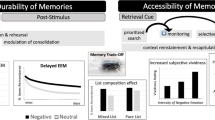Abstract
Suffering is carefully defined in contrast to pain as the psychological experience being investigated. Under consideration, however, is only one's own suffering and not the suffering of other people. Interpretation is identified as the way of perceiving personal suffering. In a nine sentence paragraph the statements describe the perceptual, affective, and action-tending components of an attitude. The implications of assuming a particular attitude are brought to light in summary fashion in another paragraph. Eleven attitudes toward personal suffering are thus described and criticized. An attitude scale of 99 items is constructed from the descriptive statements of these 11 attitudes toward personal suffering. Plans for further research are indicated.
Similar content being viewed by others
Bibliography
Berntzen, D., and Gotestam, K. G., “Effects of On-Demand versus Fixed-Interval Schedules in the Treatment of Chronic Pain with Analgesic Compounds,”J. Consulting and Clinical Psychology, 1987,55, 213–217.
Beutler, L. F., “Introduction to the Special Senses,”J. Consulting and Clinical Psychology, 1987,54, 751.
—, “Inability to Express Intense Affect: A Common Link Between Depression and Pain,”J. Consulting and Clinical Psychology, 1987,54, 752–759.
Casey, K. L., “The Neurophysiologic Basis of Pain,”Rostgraduate Medicine, 1973,53, 58–63.
Dougherty, F.,The Meaning of Human Suffering. New York, Human Sciences Press, 1982, pp. xvii, 349.
Holroyd, K. H., and Holm, J. E., “Progress in Pair Assessment,”Contemporary Psychology, 1985,30, 8–9.
John Paul II, “The Christian Meaning of Human Suffering,”Origins, 1984,13, 609–924.
Kushner, H. S.,When Bad Things Happen to Good People. New York, Schocken Books, 1981, p. 149.
Melzack, R.,Pain Measurement and Assessment. New York, Raven Press, 1983.
Millar, M. G., and Tesser, A., “Effects of Affective and Cognitive Focus on the Attitude-Behavior Relation,”J. Personality and Social Psychology, 1986,51, 270–276.
Turk, D. C., and Rudy, T. E., “Assessment of Cognitive Factors in Chronic Pain: A Worthwhile Enterprise?”J. Consulting and Clinical Psychology, 1986,54, 760–768.
Urban, B. J., “Therapeutic Aspects of Chronic Pain: Modulation of Nociception, Alleviation of Suffering, and Behavioral Analysis,”Behavior Therapy, 1982, 430–437.
Author information
Authors and Affiliations
Rights and permissions
About this article
Cite this article
Foley, D.P. Eleven interpretations of personal suffering. J Relig Health 27, 321–328 (1988). https://doi.org/10.1007/BF01533200
Issue Date:
DOI: https://doi.org/10.1007/BF01533200




